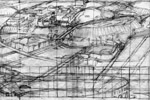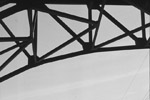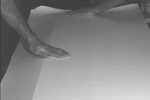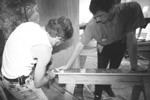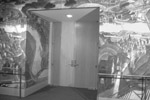
Carnegie Mellon University Center Mural (1996)

Artist: Douglas Cooper, Carnegie Mellon
Artist Assistants: Jonathan Kline + John Trivelli
Making the University Center Mural
(from Steel Shadows, University of Pittsburgh Press 2000)
In 1995, after completing the Heinz Center Mural and a large mural with the elderly for Philadelphia’s downtown justice center, I began a mural for Carnegie Mellon University’s new student center. Although this work would become my most ambitious work to date, the idea for it was not mine. It originated with Martin Prekop, Dean of Carnegie Mellon’s College of Fine Arts.
Martin asked if I might be interested in doing a mural for the new center, which was just underway and a year and a half from completion. He suggested I meet with architect Michael Dennis to find a suitable location. I think what Martin had in mind was something on the order of a 15 foot-wide mural for one of the center’s meeting rooms. But when I saw the large entrance hall in the architect’s plans, a two-story rotunda, I knew I wanted to do the mural for that space. I envisioned the mural extending three-quarters of the way around and measuring over 200 feet long.
What interested me about the rotunda was its central role in orienting visitors to the campus. It would be the first place they would come, and I thought I could use the cardinal orientations of it’s walls—north, east, and west—to place visitors in the campus and city and show a bit of the history of both along the way. The rotunda’s many openings offered an opportunity I had always sought. People would be able to see the mural from across the rotunda through the openings between its piers. The mural would not be just a picture on a wall. It would be a real landscape in its own right, and like a real landscape, it would be seen through real openings.
In the same spirit, I wanted to use the walls’ eleven-foot heights to give viewers the sense they could walk right into the mural. By following all wall returns around corners and by extending the image full-height, from baseboard to ceiling, the mural would present no visible edges. The sense I was seeking was that of an edgeless view into a space beyond.
The key compositional issue was clear from the start. Just as at the Carnegie Museum, I would need to anticipate the sight lines and distances from which the mural would be seen. But because the center was still under construction, I would have to do this using only the center’s construction plans. And the sight lines at the student center would be diagonal.
I laid out cones of vision over these plans along key sight lines, and with these in mind, I developed full-length cartoons of the mural at a scale of one inch to the foot. Working back and forth between the plans and the cartoons, I was able to anticipate exactly what would be seen through each opening and know the size at which the mural would project at various distances.
I began work on the mural in early June, 1995. I employed two assistants with ties to Carnegie Mellon: Jonathan Kline, at that time a student in architecture, and John Trivelli, a graduate of the art department. Because there were two Johns, I called John Trivelli, “JT.” I anticipated completion and installation in early June of 1996, but there was one wild-card issue. I had developed cataracts. The operation was still a ways off—the cataracts would have to “ripen” before they could be removed—but at my last checkup, it had been impossible to forecast when that would be.
We worked in a classroom in a former schoolhouse under the Parkway Bridge at the end of the Four Mile Run in Lower Greenfield. It’s an imposing building, which is now owned by a union, the Local 95 Operating Engineers. It was once the elementary school of St. Joachim’s Church, a Slavic-Catholic Church which served generations of families whose men worked in the nearby J&L iron works at the end of the run.
The 75 year-old schoolhouse seemed to have floors and walls that spoke. The water fountains and chalkboards were low to the floor so we could easily visualize the phantom children who had once attended. Here and there were initials furtively scratched into the slate. The stairs leading up to the studio still showed the yellow lines on the treads that the nuns had once used to file pupils up and down the stairs in orderly rows at lunch and recess.
In many ways these same stairs became our biggest headache. Every stick of charcoal, every gallon of acrylic, every fiber-board panel (half of which weighed over 100 pounds) had to be carried up the fifty-one steps that lead from Saline Street up to the studio, and then back down those same steps when the mural was done.
On our first day we received delivery of thirty fiber-board panels. We sealed these outside the building in the school’s former playground and then hauled them upstairs. The next day we formed our drawing surface by mounting paper with acrylic glue. We mounted the paper both front and back so the panels would not warp. These were the hottest days of that summer, as I remember, and lucky for us, Big Jim’s restaurant served cool drinks just around the corner.
